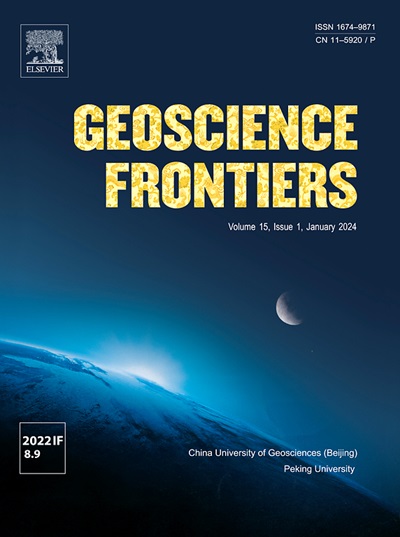Effusive and explosive silicic eruptions during India-Seychelles continental breakup: the 62.5 Ma Dongri-Uttan rhyolite sequence, Mumbai area, western Deccan Traps
IF 8.9
1区 地球科学
Q1 GEOSCIENCES, MULTIDISCIPLINARY
引用次数: 0
Abstract
Large-scale Danian-age (post-K/Pg boundary) Deccan magmatism is well known from the Mumbai metropolitan area, located in the structurally complex Panvel flexure zone along the western Indian rifted continental margin. This compositionally diverse late-Deccan magmatic suite contains subaerial tholeiitic lavas and dykes typical of the main Deccan province, with many features atypical of the Deccan, such as spilitic pillow lavas, “intertrappean” sediments (often containing considerable volcanic ash), rhyolitic lavas and tuffs, gabbro-granophyre intrusions, and trachyte intrusions containing alkali basalt enclaves. Most of these units, previously dated at 62.5 Ma to 61 Ma, are contemporaneous with or slightly postdate the 62.5 Ma India-Seychelles continental breakup and Panvel flexure formation. In the Dongri-Uttan area, two samples of a >50-m-thick, columnar-jointed rhyolite from the Darkhan Quarry and from a section behind the current Uttan Sagari Police Station have previously been dated at 62.6 ± 0.6 Ma and 62.9 ± 0.2 Ma (40Ar/39Ar, 2σ errors). New exposures reveal that these two statistically indistinguishable 40Ar/39Ar ages correspond to two distinct rhyolite units, separated by well-bedded silicic ash. The columnar rhyolites are microcrystalline, composed of quartz and alkali feldspar, with rare small (1–2 mm), altered feldspar phenocrysts, and no recognisable relict vitroclasts. Given the westerly structural dip, most of their lateral extent is submerged under the Arabian Sea, and we consider them to be possible flood rhyolite lavas. We interpret the ash beds, composed of pumice clasts and glass shards, as a low-grade (nonwelded) vitric ash, derived from a possibly distal Plinian eruption and deposited by fallout. The lavas and ash are peraluminous rhyolites. The lavas are Sr-Ba-poor and Rb-Zr-Nb-rich, and show “seagull-shaped” rare earth element patterns with deep negative europium anomalies. These crystal-poor lavas are “hot-dry-reduced” rhyolites typical of intraplate, continental rift and rifted margin settings. The very different high-field strength element contents of the lavas and the ash indicate compositionally distinct magma batches. The 62.5 Ma Dongri-Uttan sequence provides clear evidence for rapid silicic eruptions of effusive and explosive nature, alternating with each other and sourced from distinct magma chambers and eruptive vents. A newly identified, highly feldspar-phyric trachyte intrusion marks the last phase of magmatic activity in the area, corresponding with late-stage trachyte-syenite intrusions exposed in coastal western India and the Seychelles, and shows that the Mumbai rhyolites and trachytes form a compositional continuum.

印度-塞舌尔大陆分裂期间的喷流和爆炸性硅质喷发:西德干圈闭孟买地区62.5 Ma Dongri-Uttan流纹岩层序
位于西印度裂陷大陆边缘构造复杂的Panvel挠性带的孟买大都市区是著名的大规模达旦期(后k /Pg边界)德干岩浆活动。这个成分多样的德干晚期岩浆套包含了德干省典型的陆生拉玄岩熔岩和岩脉,具有许多德干的非典型特征,如细泡枕状熔岩、“圈闭间”沉积物(通常含有大量火山灰)、流纹岩熔岩和凝灰岩、辉长花岗岩侵入岩和含碱性玄武岩包体的粗纤维侵入岩。这些单元大多在62.5 Ma至61 Ma之间,与62.5 Ma印度-塞舌尔大陆分裂和Panvel弯曲地层同时或略微晚于后者。在东日乌丹地区,来自Darkhan采石场和目前乌丹Sagari警察局后面的一段的两个50米厚的柱状节理流纹岩样品先前已测定了62.6±0.6 Ma和62.9±0.2 Ma (40Ar/39Ar, 2σ误差)。新的暴露显示,这两个统计上难以区分的40Ar/39Ar年龄对应于两个不同的流纹岩单元,由层状良好的硅灰隔开。柱状流纹岩为微晶状,由石英和碱长石组成,少有小(1 ~ 2 mm)蚀变长石斑晶,无可见的残晶玻璃碎屑。考虑到西风构造倾角,其横向大部分被淹没在阿拉伯海之下,我们认为它们可能是洪水流纹岩熔岩。我们将由浮石碎屑和玻璃碎片组成的灰层解释为低品位(未焊接的)玻璃灰,可能来自远端普林尼火山喷发并由沉降物沉积。熔岩和火山灰为过铝流纹岩。岩浆贫sr - ba,富rb - zr - nb,呈现“海鸥形”稀土元素模式,具有深部负铕异常。这些贫晶熔岩是典型的板内、大陆裂谷和裂谷边缘环境下的“干热还原”流纹岩。熔岩和火山灰的高场强元素含量差异很大,表明岩浆批次的成分不同。62.5马东日-乌坦层序为快速喷发提供了明确的证据,表明该层序具有喷涌和爆炸性质,它们相互交替,来自不同的岩浆库和喷口。新发现的高长石质粗面岩侵入标志着该地区岩浆活动的最后阶段,与印度西部沿海和塞舌尔地区暴露的晚期粗面岩-正长岩侵入相对应,表明孟买流纹岩和粗面岩形成了一个组成连续体。
本文章由计算机程序翻译,如有差异,请以英文原文为准。
求助全文
约1分钟内获得全文
求助全文
来源期刊

Geoscience frontiers
Earth and Planetary Sciences-General Earth and Planetary Sciences
CiteScore
17.80
自引率
3.40%
发文量
147
审稿时长
35 days
期刊介绍:
Geoscience Frontiers (GSF) is the Journal of China University of Geosciences (Beijing) and Peking University. It publishes peer-reviewed research articles and reviews in interdisciplinary fields of Earth and Planetary Sciences. GSF covers various research areas including petrology and geochemistry, lithospheric architecture and mantle dynamics, global tectonics, economic geology and fuel exploration, geophysics, stratigraphy and paleontology, environmental and engineering geology, astrogeology, and the nexus of resources-energy-emissions-climate under Sustainable Development Goals. The journal aims to bridge innovative, provocative, and challenging concepts and models in these fields, providing insights on correlations and evolution.
 求助内容:
求助内容: 应助结果提醒方式:
应助结果提醒方式:


